2022 outlook – an “alpha year” or a headache for active managers?
2022 could be a great year for active managers. In the “goldilocks scenario”, inflation starts falling in Q1 and Omicron turns out to be manageable given high vaccination rates. Then, central banks can tighten monetary policy smoothly and gradually, in line with market expectations, and equity markets should enjoy reduced volatility and solid positive returns as the global economy continues firing on all cylinders. This would set us up for an “alpha year”, where active investors, like ourselves, can focus on doing what we do best, finding high quality companies trading at reasonable valuations.
However, 2022 could also be a difficult year for active managers, as this rosy picture has a lot of assumptions embedded into it that could easily play out differently, not least the inflation pathway and the ever-present fear of more coronavirus mutations. In this outlook we will therefore try to give a balanced picture of what 2022 could look li
On the positive side, we hope that 2022 will be a decent year for economic growth. We are also convinced that equities will remain the only game in town due to increasingly negative real interest rates and likely increasing bond yields.
For emerging markets, 2021 was a “year to forget”, dragged down by China’s “common prosperity” drive which led to underperformance. However, we feel the Chinese markets, and therewith emerging market equities, might be stabilising, hence 2022 could be a better year. At any rate, emerging market sentiment is at an all-time low, with “peak pessimism” clear in the valuations. Emerging market equities are trading at a 15-year high discount of 35% compared to developed markets, despite their outperforming developed markets (ex-US) since 2014.
We also think commodities are in for another good year, with oil enjoying positive momentum thanks to significant underinvestment and growing demand, while the energy transition metals, such as nickel and copper, are still at the early stages of a multi-decade super cycle.
1. 2022 will be a decent year for economic growth
For anyone following global supply chain struggles, it is pretty clear the world’s economy is running hot, driven by extraordinarily high demand for consumer goods. This is visible in economic growth numbers (Figure 1), with world GDP expected to grow 5.7% in 2021 and 4.7% in 2022. The 2022 figure would be the highest growth in 38 years, excluding 2021.
On the other hand, it could be fairly argued that growth is slowing down and this second derivative is often a focus point for investors. This can also be seen in the rather unimpressive EPS growth numbers (Figure 2) which are mid-single digits for both emerging and developed markets. This is in part due to the windfall year that commodities companies had in 2021, though intuitively these numbers do seem very conservative to us. This is because, while investors usually talk about real GDP growth as the driver for equities, with inflation running very high, nominal growth will also be a big driver of EPS growth. Of course, this assumes that companies will be able to pass costs on to consumers but looking at the record high EBITDA margins this year, something expected to continue into 2022, we believe this will be the case.
Figure 1. The highest economic growth for 38 years after 2021?
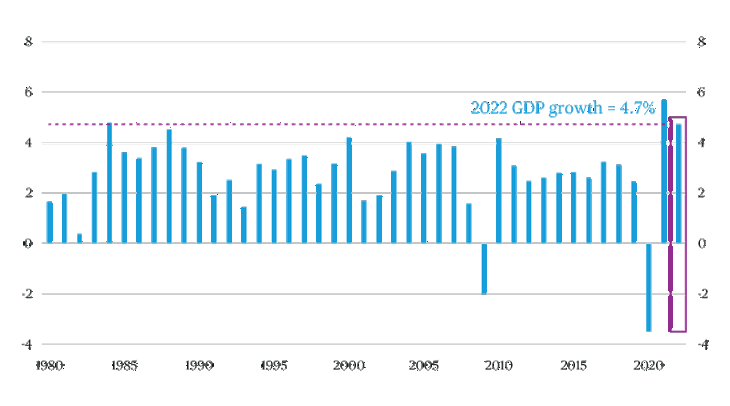
Figure 2. China stands out amidst unexciting YoY EPS growth
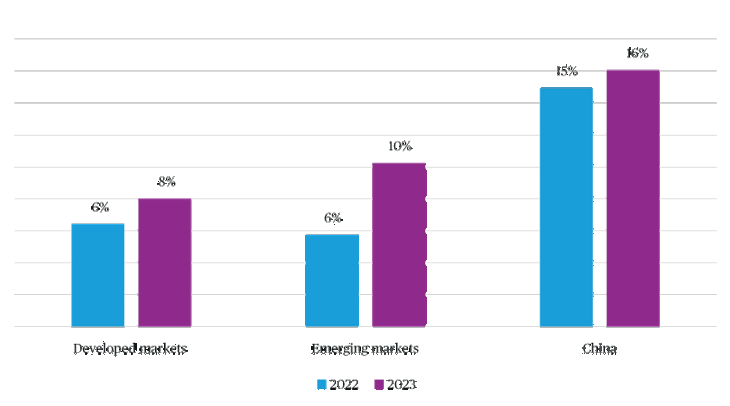
2. Equities as inflation protection?
One high conviction view we have is that equities will remain the preferred asset class for investors, given the backdrop of increasingly negative real rates. Figure 3 shows the “spot” real rates, i.e., central bank key rate minus most recent CPI print. In US and Germany inflation is running 5-6% ahead of the policy rates – de facto meaning a 5-6% negative real rate for investors. These are record low levels and will make any investor sitting on cash very nervous. This is especially true because, if anything, yields will increase along with global rates, which will, in turn, lead to capital loss as bond prices fall.
This “TINA” (There Is No Alternative) narrative is likely to continue for quite some time as inflation remains at elevated levels, even if or when it does start to fall.
This is on an ex-ante basis (Figure 4) with real yields for 10-year government paper at record lows of -2.7% in Germany and Sweden. We also include the Euro Stoxx dividend yield on this chart, to remind that even just looking at yield (rather than earnings growth), equities look significantly more appealing.
Figure 3. Central bank policy rate minus last CPI print
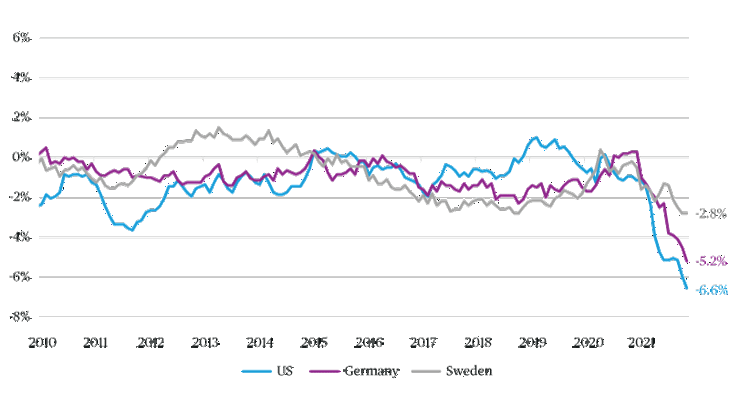
Figure 4. 10-year nominal bond yield minus CPI swap and dividend yield

3. Emerging markets are still cheap
Looking closer at emerging markets, 2021 was clearly a difficult year (Figure 5), with the index currently down 3% compared to +16% in developed markets. A multitude of factors contributed to these difficulties but, the primary driver was the unexpectedly harsh “common prosperity” drive and higher policy risk in China, which we discuss in depth in the next part of our outlook.
One main result of the underperformance of emerging markets is that they are now trading at the deepest discount compared to developed markets in almost 15 years, - 35% (Figure 6). This discount reflects the “peak pessimism” which is already priced into the market, and it is consistent with portfolio positioning. Emerging market assets currently represent around 8% of global equity assets – well below the 10-year average of 10%, and a large underweight given the 12% weight in MSCI All World index.
Therefore, we believe that there are risks (it is emerging markets after all), but these risks seem to be included in the price. In the absence of any sort of “grey swan” geopolitical event (think Taiwan or Ukraine), which would have significant implications, we would expect that investors would grudgingly return to the asset class. This is particularly true for certain markets with strong macro stories and clear top-down drivers such as Russia or for exciting themes such as cleantech, where emerging market companies dominate the space.
Another question worth asking is whether investing in emerging markets is a “lost cause”, after 10 years of underperformance versus developed markets.
Here we would point out that since 2014, emerging markets have actually outperformed developed markets by 2 percentage points (pps) when you remove the US. In 2020 they outperformed this same DM ex-US benchmark by 7 pps. The currency story is surprisingly similar, with EM currencies outperforming G10 (ex-US) by 13 pps since 2014. As such, the broader question investors should be asking is whether “investing anywhere (ex-US)” is a lost cause, as investing in Japan and Europe would have led to even bigger underperformance versus the US.
Putting all one’s eggs in the US basket seems slightly ill-advised at the moment given the well documented issues shaping up for the US in 2022. These issues include stretched valuations (S&P is trading at forward PE of 22x vs 12x for emerging markets), significant supply chain pressures, potential corporate tax hikes and messy mid-term elections (including the return of Trump?) that Democrats will likely lose.
Figure 5. Total return YTD in USD
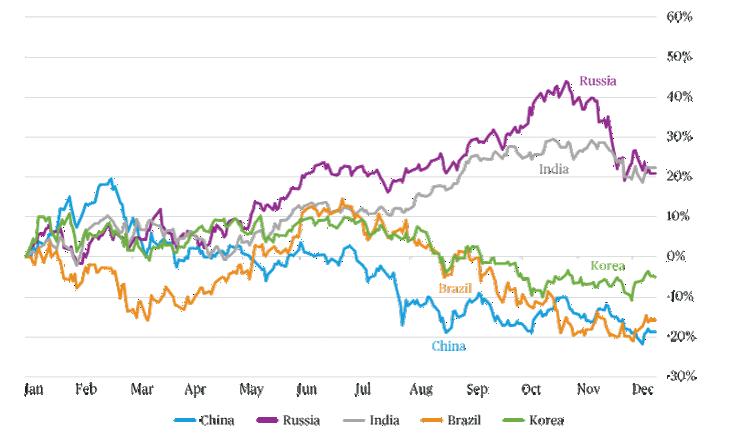
Figure 6. Forward PE ratio of Emerging Markets as % of Developed Markets
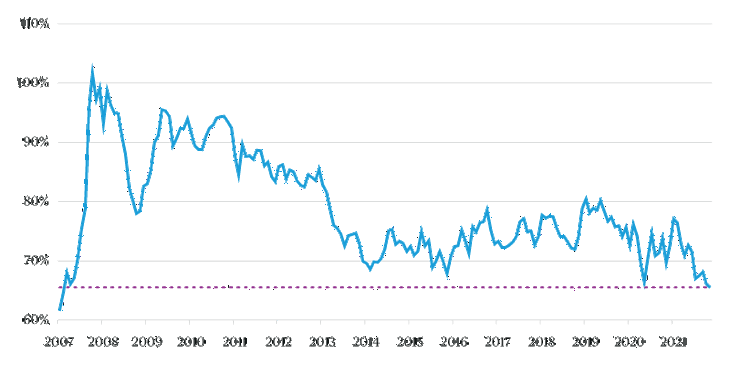
4. Is China turning a corner?
2021 was a difficult year for China which, at 33% of the emerging market index, is for many global investors driving the emerging markets story.
One important factor behind Chinese equities’ underperformance is higher policy risk. President Xi’s “common prosperity” drive saw sweeping reforms that hit the education, gaming and fintech sectors at a time when market sentiment was already quite poor, impacted by weaker local consumption, power crunch, concerns over real estate giant Evergrande’s default and Beijing’s rather tight credit and monetary policies. This was exacerbated by further regulation of cybersecurity, personal data use and algorithms, and ride-sharing company Didi’s decision to delist from NYSE six months after its blockbuster IPO. Add to that increased scrutiny by both Chinese and US regulators of VIE structures of US-listed Chinese ADRs and, underperformance is perhaps understandable
One relatively simple approach to manage these risks is to invest in sectors with lower policy risks, and here a sustainability lens works well.
For example, Chinese cleantech companies – one of our preferred investment themes – dominate many parts of global renewable energy and NEV supply chains and they have multi-year growth trajectories ahead of them. Many companies, especially those higher up the value chain, are trading at fractions of their western peers, though offering comparable structural growth opportunities and limited domestic policy risk. With faster than expected adoption, EV sales in China will exceed 3 million units in 2021, comprising more than 50% of global EV sales. Another exciting sector is solar, which we expect will grow at above 30% CAGR in the coming five years and beyond, as the energy transition picks up steam. China stands to benefit most as they have over 90% global market share across most parts of the supply chain. One fact, often overlooked by investors, is that Chinese companies represent an astonishing 90% of total market capitalisation of globally listed solar stocks.
From a macro perspective, while we do believe that the days of 8-9% of GDP are behind us, growth of 5% is still above global average, and we don’t believe China’s slowdown will have too pronounced of an effect on the global economy, apart from perhaps in certain base metals.
Growth is likely to be supported by a slight easing of monetary policy (as opposed to a general tightening trend for other major economies) which will be additional tailwind for stock market performance. We saw the first signs of this easing recently with the 0.5 pps cut to the reserve requirement ratio for banks on December 14th. Combined with various other liquidity actions this should inject around CNY 1.2 trillion, which is equivalent to an average month’s new yuan loan. Chinese Communist Party’s 20th Congress, during which Xi is expected to secure a third term, will be held in October 2022 and this implies that the government will strive to maintain its priorities in terms of stable economic growth and draconian anti-covid measures during 2022.
From an earnings growth standpoint, China is considerably above both emerging and developed markets, at 15% for 2022, compared to 5-6% for the latter markets (Figure 3). At the same time, its forward PE multiple is 12.3x, at 5-yr average. Given all the above, plus a strong currency outlook supported by positive real rates and strong current account, we believe Chinese equities are well-placed to deliver strong performance in 2022. This is further supported by a substantial underweight of China by global investors.
5. Commodities
2021 has proven to be a wild ride for commodities, with natural gas having been the star performer as the EU spot prices returned 333% year-to-date and 648% since the start of 2020 (at the time of writing). Also worth highlighting, The EU carbon price, often overlooked by investors, is up 127% this year and 228% since the start of 2020. It is currently above USD 100 / t CO2.
If we look at the longer-term story (Figure 7, not adjusted for inflation), it is clear that most commodities are at record highs, with the odd one out being oil, which is well off highs of USD 135 / bbl that we saw in 2008.
Figure 7. Total return since 2000
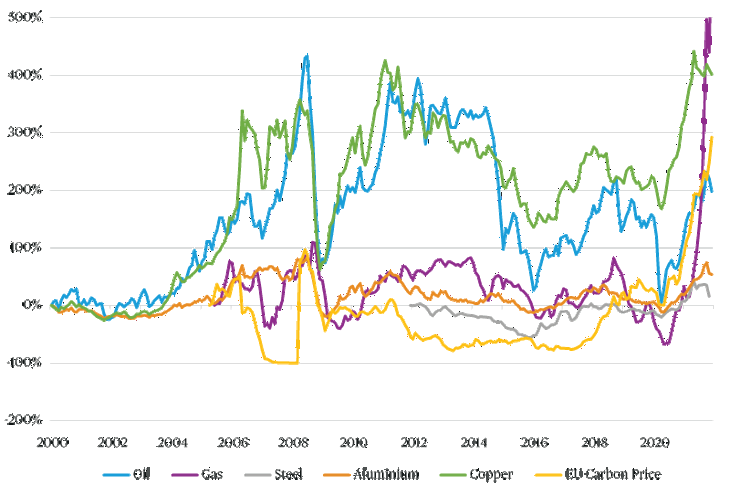
Looking ahead into 2022, there are two commodity classes we are focusing on:
a. Energy transition metals entering a new super cycle
One of our key investment themes over the year has been best-in-class miners with large exposure to transition metals. Such metals include copper, nickel and to some extent aluminium - cobalt and lithium are equally exciting, though there are less investible emerging market mining companies that offer exposure to these metals. We believe these metals are at the start of a multi-decade super cycle due to unprecedented levels of demand driven by the energy transition, from EV car batteries to solar panel installations.
For example, Figure 8 shows our expectations for nickel demand over the next ten years. Overall demand will grow some 87% in 10 years (6% CAGR), driven by 23% CAGR growth from EV battery demand. This is likely to have a very significant impact on price, especially for high-grade nickel used in batteries.
Figure 8. Nickel demand from batteries will grow at 23% CAGR, reaching 28% of total nickel demand in 2030
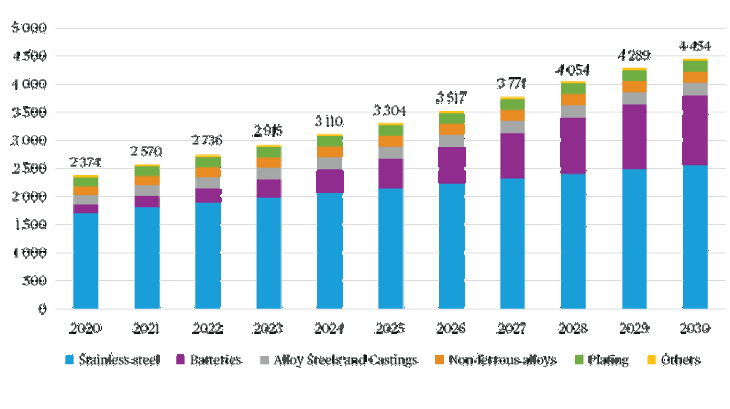
b. A strong year for oil and gas?
As demand bounced back after the initial covid hit, the oil market has been in consistent deficit since the summer of 2020 (Figure 9). We expect this market tightness to continue as demand increases, and we cannot rule out spikes above USD 100 / bbl in the summer as the US driving season starts. This is especially the case because spare capacity remains limited, and it is telling that OPEC+ is operating at 116%, in compliance with their quotas as of October (i.e. over complying), as many countries struggle to increase production.
One of the main reasons for the market tightness is that, like many commodities, oil has faced significant underinvestment since 2014, due to cyclical factors and pressure from capital providers (Figure 10). Goldman Sachs recently estimated that the cost of capital for long-cycle oil projects is 20% compared to 3-5% for renewables projects. As a result, 2021 upstream oil and gas capex should be 54% below the 2014 level, despite oil demand increasing by around 5mb/d since then to 96 mb/d.
We see the high prices for all fossil fuels (including coal) as generally driven by underinvestment and a necessary evil required to wean the world of fossil fuels. In a sense, they are the capital market’s way of imposing a carbon price on fossil use and, as such, stepping up where government action has been extremely limited.
For gas, prices are abnormally high, reflecting the significant risk premium of an extremely cold winter. We are already seeing signs this could be possible with “below, much below and strong below” temperature anomalies in many countries in Europe.
Generally, when we emerge from the winter, we believe we will be at a “new normal” for prices, which will be considerably higher than previous levels. This will be exacerbated by the carbon pricing in Europe, which will deter coal burning.
Figure 9. Demand rebounded much quicker than supply (mb/d)

Figure 10. Global upstream oil and gas capex (USDbn)

Conclusion
Throughout this piece we have tried to remain humble and highlight the significant uncertainty facing markets for 2022. While we like to refer to the year as an “alpha year”, we are under no illusion that it is going to be straightforward. Having said that, we do hope that inflation will come down in an orderly fashion, coronavirus remain manageable and demand continue to surge. In this scenario, central bank action would be predictable and moderate, volatility would subside, earnings would be revised upwards and markets would post strong performance.
Of course, if fears of inflation becoming more permanent lead to more drastic central bank action and higher discount rates or if coronavirus surges lead to fresh waves of country-wide lockdowns, then we could see a more difficult year.
Regardless of the scenario, fundamentals will come increasingly in focus as central bank liquidity reduces, which is positive for managers like ourselves who build their portfolios around companies offering structural growth at reasonable prices and strong attention to ESG risks and opportunities. More generally though, we will remain focused on building resilient portfolios robust to a wide range of top-down scenarios, and constantly reassess our positioning based on market movements and macro developments.





